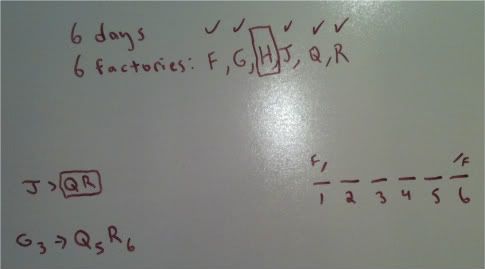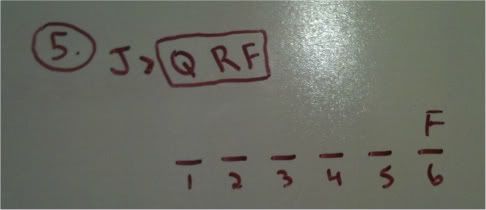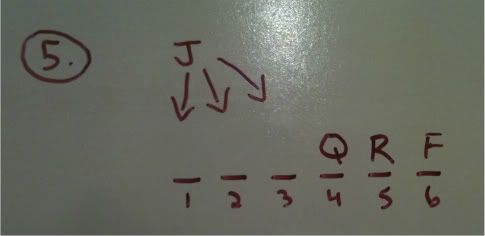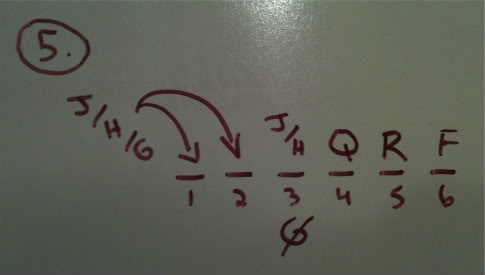Q5 says If the inspection is scheduled for the day immediately before the inspection of F, which one of the following must be true about the schdule?
I think I'm not getting the point of the question or I am totally lost in setup. Could anyone plz help me with the question? Why D is the answer?
LSAT Forum
5 postsPage 1 of 1
-

- timmydoeslsat
-
Thanks Received: 887
-
Atticus Finch

- Posts: 1136
- Joined: June 20th, 2011
- This post thanked 4 times.

- Most Thanked

- First Responder
Re: Q5
This can be seen as a global diagram for this game

The checkmarks indicate that the variable was used in a rule. The boxed-in variable is one that is completely random. It has no rules governing it. That variable is H.
There are 4 rules. I built in the first rule into my diagram.
The second and third rules can be combined.
The fourth rule is a conditional statement. It is important to note the contrapositive of this rule, I do it in my head, but for clarity it is:
~Q (5) ---> ~G (3)
(~ = not)
Question number five gives us a local condition that can be initially noted as this:

What else can we infer from this local rule? We know that Q is immediately before R. We also know that J comes at some point before Q.

The next thing we can consider is the placement of this " J > block "
We know that F must be either first or sixth. In this case, it must be sixth because it has variables that come before it.

We know that the block indicates that Q and R are directly next to F. We know that J must simply come before those variables.

We are not done looking at the rules that have been giving to us.
It is important to consider that we only have three variables left to place: J, which at this point has no rules governing it anymore, H, which has no rules governing it, and G, which does have one rule governing it. When G is third, QR fill spots five and six.
We know that in this scenario QR do not fill in those spots, which means, via the contrapositive, that G will not fill the third spot. That means the third spot has only two contenders: J and H.

This is represented by choice D. This is something that MUST be true.

The checkmarks indicate that the variable was used in a rule. The boxed-in variable is one that is completely random. It has no rules governing it. That variable is H.
There are 4 rules. I built in the first rule into my diagram.
The second and third rules can be combined.
The fourth rule is a conditional statement. It is important to note the contrapositive of this rule, I do it in my head, but for clarity it is:
~Q (5) ---> ~G (3)
(~ = not)
Question number five gives us a local condition that can be initially noted as this:

What else can we infer from this local rule? We know that Q is immediately before R. We also know that J comes at some point before Q.

The next thing we can consider is the placement of this " J > block "
We know that F must be either first or sixth. In this case, it must be sixth because it has variables that come before it.

We know that the block indicates that Q and R are directly next to F. We know that J must simply come before those variables.

We are not done looking at the rules that have been giving to us.
It is important to consider that we only have three variables left to place: J, which at this point has no rules governing it anymore, H, which has no rules governing it, and G, which does have one rule governing it. When G is third, QR fill spots five and six.
We know that in this scenario QR do not fill in those spots, which means, via the contrapositive, that G will not fill the third spot. That means the third spot has only two contenders: J and H.

This is represented by choice D. This is something that MUST be true.
-

- VladimirI226
-
Thanks Received: 0
-
Vinny Gambini

- Posts: 1
- Joined: January 02nd, 2018
Re: Q5
I understand that G can not be third. I would like to know why Answers A, B, C that deal with position 1 and 2 are not the correct answers. How are those answers eliminated as viable options. Element J,G, and H can easily be placed in position 1 and 2. I guess this is the difference between the could be true and must be true answer.
-

- ED310
-
Thanks Received: 0
-
Vinny Gambini

- Posts: 1
- Joined: November 06th, 2018
Re: Q5
Please explain Why answer choice A is invalid. Which rule does (A) violates?
A) G/H → Day 1
{ H,G,J,Q,R,F} or {G,H,J,Q,R,F} What is wrong with this pattern?
Rule #1: F→1/6 √
Rule # 2: J is earlier than Q √
Rule # 3:Q is immediately before R√
Rule # 4: Conditional rule G(3)→ Q(5) √

A) G/H → Day 1
{ H,G,J,Q,R,F} or {G,H,J,Q,R,F} What is wrong with this pattern?
Rule #1: F→1/6 √
Rule # 2: J is earlier than Q √
Rule # 3:Q is immediately before R√
Rule # 4: Conditional rule G(3)→ Q(5) √

-

- ohthatpatrick
-
Thanks Received: 3808
-
Atticus Finch

- Posts: 4661
- Joined: April 01st, 2011
Re: Q5
Q5 is a MUST BE TRUE question, but it seems like you're evaluating it as though it's a COULD BE TRUE question.
We're not here to analyze, in the case of (A), whether G or H could go 1st.
We're being asked whether they MUST go first?
In other words, when we look at (A), we ask ourselves, "Is there anyone besides G or H who can go 1st?"
Whenever you're judging MUST BE TRUE answers, you're trying to see if you can contradict them (not match them).
The combination of rule 3 (QR) and the condition for Q5 (RF) and the fact that rule 1 forces F to be 1 or 6, means that we have to be dealing with this.
__ __ __ Q R F
G, H, and J remain. We can't put G on day 3, or else we'd break rule 4. But otherwise, it doesn't matter what we do with them.
__ __ H/J, Q R F
A) J G H Q R F is possible, so it doesn't HAVE to be true that G or H is 1.
B) H G J Q R F is poss, so it doesn't HAVE to be true that G or J is 1.
C) G H J Q R F is poss, so it doesn't HAVE to be true that G or J is 2.
D) YES, we know this must be true. QRF are already assigned to 4/5/6, and G can't go 3rd in this scenario, so that means that H or J will HAVE to go in 3.
E) This is actually impossible, since Q is definitely in spot 4.
We're not here to analyze, in the case of (A), whether G or H could go 1st.
We're being asked whether they MUST go first?
In other words, when we look at (A), we ask ourselves, "Is there anyone besides G or H who can go 1st?"
Whenever you're judging MUST BE TRUE answers, you're trying to see if you can contradict them (not match them).
The combination of rule 3 (QR) and the condition for Q5 (RF) and the fact that rule 1 forces F to be 1 or 6, means that we have to be dealing with this.
__ __ __ Q R F
G, H, and J remain. We can't put G on day 3, or else we'd break rule 4. But otherwise, it doesn't matter what we do with them.
__ __ H/J, Q R F
A) J G H Q R F is possible, so it doesn't HAVE to be true that G or H is 1.
B) H G J Q R F is poss, so it doesn't HAVE to be true that G or J is 1.
C) G H J Q R F is poss, so it doesn't HAVE to be true that G or J is 2.
D) YES, we know this must be true. QRF are already assigned to 4/5/6, and G can't go 3rd in this scenario, so that means that H or J will HAVE to go in 3.
E) This is actually impossible, since Q is definitely in spot 4.
5 posts Page 1 of 1